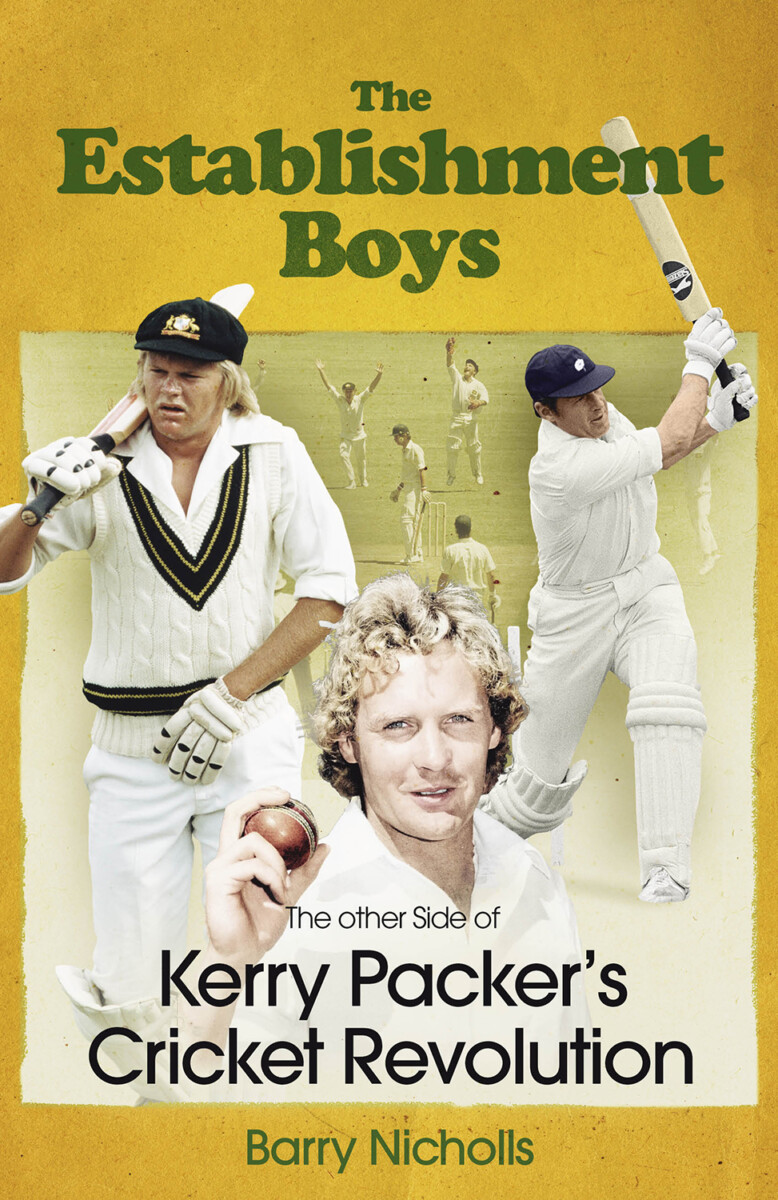No products in the cart.
Description
The other side of Kerry Packer’s Cricket Revolution, foreword by Mike Coward.
Revised and updated, lots of illustrations including Hoggie and Rick Darling on the cover. Extra interviews not to be found in the first edition with Sam Gannon, Steve Rixon, John Dyson, Graeme Wood and Peter Sleep… plus much extra research.
This new and improved edition of The Establishment Boys is most welcome.
The 2015 original, a fast-tracked hardback, was riddled with typographic mistakes without author Nicholls being able to even see the final proof.
Many of the conversations are candid, like David Ogilvie talking about Australia’s comeback captain Bobby Simpson. ‘I don’t think he was a particularly good manager of people,’ says Ogilvie. ‘There was a fair age difference (between us). I might have wanted more from Simpson on a one-one basis. And I’m sure “Simmo” wanted more from me.’
Of the 20 players to debut for traditional Australia during the 1977-79 period, many were to disappear as quickly as they arrived.
Their stories are faithfully recorded. – KP
Additional information
| Year Of Publication |
|---|
1 review for Nicholls, Barry – The Establishment Boys, 2024 UK edition
Add a review Cancel reply
You must be logged in to post a review.
Related products
-

Moyes, AG ‘Johnnie’ – Australian Cricket: A History
$27.50 Add to cart -
Sale!

Downer, Sidney – 100 Not Out (special price)
$27.50Original price was: $27.50.$2.20Current price is: $2.20. Add to cart -
Sale!

Dawson, Graham and Charlie Wat (edit) – Test Cricket Lists
$11.00Original price was: $11.00.$1.10Current price is: $1.10. Add to cart -
Sale!

Meher-Homji, Kersi – 1000 Tests (Greg Chappell on cover)
$11.00Original price was: $11.00.$5.50Current price is: $5.50. Add to cart




Ken Piesse –
Advance review by Ken Piesse
When Kerry Packer shocked Australia’s cricket establishment with his spendthrift ways and rival professional troupe in the late 1970s, the beneficiaries were numerous, today’s Big Bash a pure and exhilarating extension of the Packer vision.
In ushering a fresh professionalism into the game, with elevated wages befitting those who best play the national game, the initial angst felt when a 41-year-old was recalled to captain a third-strength Test team has long passed.
As Packer positioned his Supertests in direct opposition to traditional Tests, bitter divisions resulted, Sir Donald Bradman not speaking to Richie Benaud for two years.
New Test caps were handed out scattergun, like beers at a barbie, 23 being called up to make their Test debuts in the 24 months of World Series Cricket.
Most fell away, hardly to be heard of again, but as author Barry Nicholls reminds us in The Establishment Boys, the stories of many of the unknowns are just as riveting and compelling as those like Border, Hughes and Hogg who also debuted and flourished.
Until now, coverage of the Australian establishment summers of 1977-78 and 1978-79 and a springtime tour of India in 1979 have been minimal and told through the eyes of only a few. Here in The Establishment Boys, the accounts are warts-and-all from the ‘three-star dumps’ Hogg complained about in India to the outrage widely felt at the bombastic treatment of Kim Hughes by his West Australian ‘seniors’ Dennis Lillee and Rodney Marsh.
The interviews in this book are truly illuminating from the likes of Carlson, Moss, Hurst, Wright, Mann and Serjeant – players who were gone from international ranks almost as quickly as they arrived.
Cricket in the ‘70s was very much run along English feudal lines with the masters and the surfs. Australian captains Bob Simpson and Graham Yallop had only a manager as support. Sometimes they showed and sometimes they didn’t, saddling them with the responsibility of organising taxis, breakfast menus, practice schedules and media appearances.
Under Simpson a generation gap was soon evident, even his vice-captain growing tired of ‘the old man’s rants’. Under Yallop his lead fast bowler invited him around the back of the stands at Adelaide Oval – and he didn’t have a game of tennis in mind.
Several of those who remained loyal to the dream of wearing an official Australian Test cap wish they had caved in and accepted the Packer-rands. Another was so upset by his in-and-out standing within the best establishment XI that he doesn’t even have his baggy green caps any more.
The backlash against those who had signed with Packer was so considerable that starlet David Hookes, returning from a broken jaw, was banned from Adelaide club ranks from wearing his motor-cycle helmet, because, authorities claimed, it had ‘the stench’ of World Series Cricket.
The stories of disdainful management from the Australian Cricket Board are staggering, even now, almost 40 years on.
Unlike now where there is a second team of specialists looking after the whims of every player at national XI, the Board simply ratified the chosen XII and let them sink or swim. Gary Cosier, one of the many establishment vice-captains in the Packer years, found out he’d been dropped for the last time via a phone call from his mother. She’d heard it on the news.
Those in charge in Jolimont were simply not in touch. Speaking after England had reclaimed the Ashes 4-1 with a Test to play in 1978-79 (which they also lost), Australia’s selection chairman Phil Ridings famously said there wasn’t that much between the sides! Lucky for him, the p-r system broke down and his comments were heard by only a few, including the author, a lifelong cricket fan and capable first XI club batsmen for years in Adelaide.
This reviewer didn’t know that Rod Hogg swapped one of his baggy greens for a police officer’s lapel ID, baton and handcuffs or that the Australian manager on duty seriously discussed with captain Kim Hughes about a despondent and critical first-time tourist Allan Border being sent home in mid tour from India in 1979.
There is gold in this book and it deserves to do well.